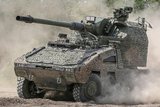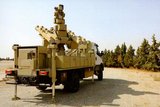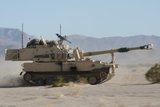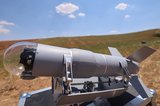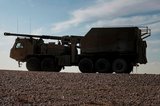BAE Systems conjures up invisibility cloak
BAE Systems has tested an ‘invisibility cloak' that allows a vehicle to blend into its surroundings. The system, which can work over infra-red and other frequencies, will be displayed in infra-red mode on a BAE Systems CV90 armoured vehicle at the UK Defence and Security Equipment International exhibition later this month.
Known as "Adaptiv", the patented technology is based on sheets of hexagonal 'pixels' that can change temperature very rapidly. On-board cameras pick up the background scenery and display that infra-red image on the vehicle, allowing even a moving tank to match its surroundings. Alternatively, it can mimic another vehicle or display identification tags, reducing the risk of fratricide.
Current work focuses mainly on the infra-red spectrum, as this is most important to the Swedish Defence Materiel Administration (FMV), which funds part of the work. However, BAE Systems engineers have combined the pixels with other technologies, which provide camouflage in other parts of the electro-magnetic spectrum at the same time to provide all-round stealth, which will be developed further over the next few years.
Trials by BAE Systems in mid-July showed that one side of a CV90 could be made effectively invisible or appear to be other objects, including a 4x4 vehicle, when viewed in the infra-red spectrum.
Project manager, Peder Sjölund explains: "Earlier attempts at similar cloaking devices have hit problems because of cost, excessive power requirements or because they were insufficiently robust. Our panels can be made so strong that they provide useful armour protection and consume relatively low levels of electricity, especially when the vehicle is at rest in 'stealth recce' mode and generator output is low."
He adds: "We can resize the pixels to achieve stealth for different ranges. A warship or building, for instance, might not need close-up stealth, so could be fitted with larger panels."
Source: BAE Systems
More from Land Warfare
-
![Can Iranian air defence systems compete for exports?]()
Can Iranian air defence systems compete for exports?
Iran’s defence industry is now producing a range of surface-to-air missile systems and has begun to market them internationally. Using what appears to be a mixture of original and reverse-engineered elements, how do they stack up compared to other countries’ offerings?
-
![Supply of new self-propelled guns is rising to meet looming demand]()
Supply of new self-propelled guns is rising to meet looming demand
As the need for self-propelled artillery continues to climb across Europe and NATO-allied nations, orders for existing capabilities continue to roll in while new and improved weapons are on the way.
-
![US Army seeks industry support to prepare acquisitions of Group 4+ UAVs]()
US Army seeks industry support to prepare acquisitions of Group 4+ UAVs
The US Army is keen to hear about vendor designs, strategies and potential hardware and software solutions to inform requirements for procurement efforts.
-
![Dedicated drone munitions could unlock modular mission potential]()
Dedicated drone munitions could unlock modular mission potential
Top attacks have proven effective against heavily armoured vehicles in Ukraine. A new family of uncrewed aerial system-delivered munitions is looking to press that advantage further.
-
![Elbit bets on local content for US howitzer bid as it faces off against popular systems]()
Elbit bets on local content for US howitzer bid as it faces off against popular systems
The Israeli company hopes that producing its Sigma artillery system wholly in the US will help it win a key US Army contract, but it will be up against the popular CAESAR Mk II wheeled weapon and the K9 tracked.










